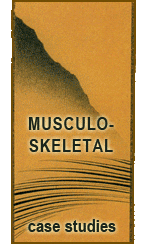Acupuncture and Herbs used for Shoulder Pain

Chief Complaint: Right shoulder pain in LI-15 area
Western Diagnosis: X ray confirms calcium deposit on anterior aspect of humerus, between heads of biceps brachii tendons.
Medical History: 41 y.o. female, attorney. First noticed the pain about two years ago while in a stressful court trial. Multiple Sclerosis diagnosed at age 19. Auto accident five years ago with subsequent back pain. Smokes cigarettes, drinks alcohol moderately, and acknowledges that she is overweight and doesn’t exercise enough. Diet consisted of a lot of business lunches eaten hurriedly while reading stacks of legal briefs. At present,the pain is a constant dull ache which occasional sharp stabbing sensations which make her feel nauseous. She has tried massage and chiropractic and is trying acupuncture as a last resort to surgery to remove the calcium deposit.
Questioning exam: Every other menstrual cycle she experiences strong cramping pain in the low abdomen, with the flow stopping and starting. Her job is demanding and she doesn’t like to take time off to rest. When asked about the MS, she said she doesn’t like to talk about it.
Pulse exam: Tenderness throughout the scapular region, especially GB21 , LI15. Pulse was slippery, weak, especially in the third position.
Tongue exam: Teethmarks, puffy, slightly http://pharmacy-no-rx.net wet, red dots on the tip.
OM Diagnosis: Diagnosis: Qi and Blood Stasis on the LI channel. Underlying Spleen Qi Deficiency, Liver Qi Stagnation, Kidney Jing Deficiency (MS).
Treatment Principle: Move Qi and Blood in the shoulder. Tonify Spleen Qi, Move Liver Qi, Tonify Kidneys.
Point Prescription: Right LI15, PC2; Bilateral: LI4, LR3, K3, SP6, ST38, extra point Jianneiling; Stick moxa applied to shoulder, SP6, K3.
Lifestyle Prescription: Herbal Plasters for shoulder.
Results: Patient discontinued therapy after four treatments with limited results. Stick moxa produced the most noticeable improvement, but of very short duration.
Synopsis: Travell and Simons maintain that calcific deposits at the insertion of the tendon can be resolved with the inactivation of trigger points in the supraspinatus muscle. This strategy might have yielded fruitful results if patient had been motivated to continue treatment. In my opinion, given the complexity of the other factors in patient’s history and lifestyle such as diet, emotions, a stressful job, the MS, these too probably played a significant role in the etiology of the calcium deposit formation, and needed addressing in order to dissolve the deposit. Four treatments were clearly insufficient to resolve this case, though I was surprized the acupuncture produced such limited results.
 Last modified: September 8, 2009
Last modified: September 8, 2009  Tags: Acupuncture, shoulder pain В· Posted in: Musculo-Skeletal
Tags: Acupuncture, shoulder pain В· Posted in: Musculo-Skeletal
